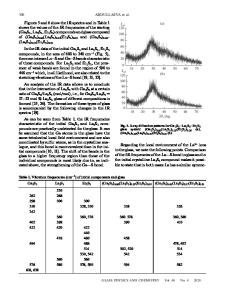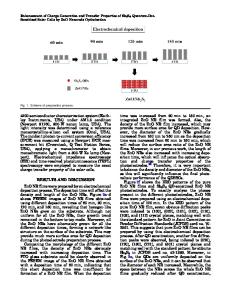Preparation and enhancement of second-order nonlinearity of hybrid PMMA/SiO 2 glass with Sb 2 S 3 nanocrystals
- PDF / 812,115 Bytes
- 6 Pages / 584.957 x 782.986 pts Page_size
- 44 Downloads / 460 Views
Bulk hybrid polymethyl methacrylate (PMMA)/SiO2 glass with Sb2S3 nanocrystals was prepared by the sol-gel process. We tried to minimize the quantity of water as much as possible in tetraethyl orthosilicate (TEOS) hydrolyzing, prepolymerized the organic monomers, mixed inorganic precursors, and prepolymerized organic monomers under a noncosolvent condition to reduce possible volume shrinkage. A silane coupling agent, which hydrolyzed simultaneously with TEOS, was introduced into the system to improve the miscibility of the organic and inorganic materials. The maximum dopant of Sb2S3 was 9 wt% in our experiments. The second-harmonic generation was observed in the hybrid PMMA/SiO2 glasses with electron-beam poling. Second-harmonic intensity increased with increase of accelerating voltage, current, and the content of Sb2S3 nanocrystals. The maximum w2 in our study, as large as 1.64 p.m./V, was obtained under the optimized poling condition conducted at 25 kV, 20 nA, and 10 min. It was indicated from the thermally stimulated depolarization current measurements that the nonlinear layer was located in the thin 10-mm irradiated surface of the glass.
I. INTRODUCTION
Great achievements have been obtained for amorphous nonlinear optical materials since Franken1 first observed the double frequency effect.2,3 Now more researchers are trying to prepare different amorphous materials in different ways to improve their nonlinearity.4,5 Hybrid organic– inorganic nanocomposites with high nonlinearity have attracted great attention recently,6,7 especially hybrid organic–inorganic materials prepared by the sol-gel process that are largely exploited as novel materials. The various great characteristics of the sol-gel process (metal organic precursors, organic solvents, low processing temperature, processing versatility of the colloidal state) allow the introduction of organic molecules inside an inorganic network.8 Inorganic and organic components can be mixed at the nanometer scale, which induces the formation of the so-called hybrid organic–inorganic nanocomposites.9,10 These hybrids are extremely versatile in their composition, processing, and optical and mechanical properties.11,12 Homogeneously dispersed organic–inorganic hybrid materials can be synthesized by the hydrolytic sol-gel process through hydrolysis-condensation reactions of alkoxide precursors.13 Because they present several advantages for designing materials for optical applications (versatile and relatively facile chemistry, easy shaping a)
Address all correspondence to this author. e-mail: [email protected] DOI: 10.1557/JMR.2009.0312 J. Mater. Res., Vol. 24, No. 8, Aug 2009
http://journals.cambridge.org
Downloaded: 16 Mar 2015
and patterning, good mechanical integrity, and excellent optical quality), numerous silica-and/or siloxane-based hybrid organic–inorganic materials have been developed recently.14,15 Polymethyl methacrylate (PMMA)/SiO2 is one kind of promising hybrid material. PMMA has good transparence and fracture resistance, and its density is half of co
Data Loading...











